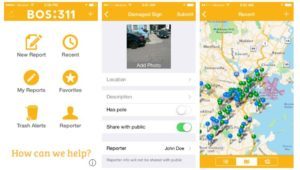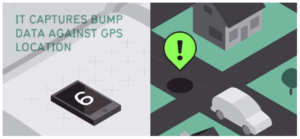311 and Beyond: App-Driven Civic Engagement in Boston

Boston has launched a suite of apps to bring citizens into conversation with government. The next step: how can it leverage data to improve decision-making?
Boston makes a promise to its residents, businesses, and visitors that it can deliver a vibrant urban life that is clean, safe, and affordable. One need look no further than the streetscape to evaluate the city’s ability to deliver on “the basics” (is my neighborhood clean of litter and graffiti? Are the roads I drive full of potholes?). City Hall has now embraced the digital revolution to boost civic engagement, improve basic infrastructure, and streamline its operations.
Boston 311: Crowdsourcing Complaints to Enhance Public Works

The Citizens Connect mobile app debuted in 2009 as the country’s first 311 app. Its simple design promised a quick and easy reporting experience and status updates. The app thereby lowered the barrier for citizens to participate in addressing the city’s non-emergency issues. The menu of service options focused on those problems that the City could reliably repair — e.g., an unplowed street or a fallen tree — so that “people could get immediate gratification.” [1]
In 2015, Boston re-launched the app as a multi-channel 311 platform with expanded service options – giving citizens the ability to reach out via app, online, social media, or phone to a single, branded resource. [2] The results of this digital intervention are significant:
“On average, the Mayor’s 24-Hour Hotline receives 5,762 calls per week, and more during times of severe weather… Additionally, constituents are increasingly relying on digital channels to report issues: [in 2015], 39 percent of requests have been submitted online and through the mobile app.”[3]
And how does Boston manage a growing stream of inquiries and complaints? Back in City Hall, a dedicated 311 team processes complaints, routes them to proper departments, and tracks resolution (including photos of a completed job!).[4] Previously, the City relied on citizens to vocalize complaints to distinct departments, utilized analog systems to track resolution and costs, and lacked a channel to communicate outcomes to the aggrieved party. [5] The 311 platform has thereby centralized the way information flows through the organization to create and demonstrate value for the citizen.
StreetBump: Sensing Vibrations to Improve Road Quality

Boston continued its quest to improve its roads by launching StreetBump in 2012. The app senses road vibrations to predict the locations of potholes. [6] Boston drivers are encouraged to download the app and allow it to collect data while they navigate the streets. Adoption certainly isn’t as widespread as 311, but initial findings have been illuminating:
“While residents most frequently report problems about potholes, the biggest cause of bumps is sunk manhole covers (a problem found four times as frequently as potholes.) Working with utility companies, 1,250 of the worst manhole covers have been fixed.”[7]
Here, a platform-enabled information flow from the driver to the City uncovered a root cause that previous investigations did not surface, and led to speedy and targeted issue resolution. These results only hint at the possibilities for wider dissemination of similar sensing and tracking technologies in cities – from crime to public health to weather.
Next Steps: Processes for Data-Driven Decision-Making
Boston’s investments in civic engagement tools are predicated on a simple set of assumptions that align with their citizen promise: that transparent, responsive service delivery will enhance Boston’s attractiveness as a place to live, work, and visit, generating more tax and fee revenue as a result. But increasing the size of Boston’s $2.9B municipal budget is only one part of the value digitization can create; these apps can also lower costs for the organization by anticipating and solving for the City’s resource needs. [8]
For Boston to realize its full potential in operational efficiency, the City must embed these technologies in a set of business processes to connect data to decisionmaking. In an ideal world, 311 and SmartBump can help the City forecast type, frequency, and location of public works issues, and thus inform hiring, capital expenditure, and emergency preparedness decisions. The City’s analytics capabilities, however, are relatively nascent: only in May 2016 did Mayor Walsh appoint a Chief Data Officer to manage the projects that pair data with operational improvement.[9] The team will likely confront several difficult questions, including:
- Data Quality: With a suite of distinct civic apps at their disposal, how can the City maximize data quality without overwhelming citizens with too many platforms?[10]
- IT for IT’s sake: How can the City ensure that their investments in technology actually build upon one another and fit within existing practices and communication norms?
Boston certainly understands the power of data in improving its citizens’ lives. If the City can successfully integrate that information into human processes that enhance efficiency across the value chain – from citizen to government and back – it will free up public resources for other meaningful initiatives.
(786 words)
[1] Weiss, Mitchell. “More Citizens Connect.” Harvard Business School Case 315-075, January 2015.
[2] http://sparechangenews.net/2016/09/bostons-311-line-can-now-connect-citizens-with-recovery-services/
[3] http://www.cityofboston.gov/news/default.aspx?id=20283
[4] http://www.governing.com/columns/tech-talk/col-boston-app-reward-citizens.html
[5] Interview, former intern at Boston’s Office of New Urban Mechanics, November 2016.
[6] http://www.govtech.com/wireless/Boston-Testing-App-for-Auto-Detecting-Potholes.html
[7] http://newurbanmechanics.org/project/streetbump/
[8] http://www.cityofboston.gov/news/default.aspx?id=20197
[9] http://www.cityofboston.gov/news/default.aspx?id=21642
[10] http://www.cityofboston.gov/DoIT/apps/



This is incredible! I had no idea Boston was so forward-thinking in utilization of digital to enhance communication and coordination. Whenever it comes to municipal processes, I just assume it’ll involve paperwork and snail mail (when I found out I could check my NY voter registration online I nearly cried with joy). This is a fantastic step and I absolutely agree that IT processes need to be built to integrate with business processes and with each other. Most people will assume city governments don’t have mobile apps – the city could do so much more in terms of marketing and increasing their user base. In addition, as of 2015, only ~64% of Americans have smartphones (http://www.pewinternet.org/2015/04/01/chapter-one-a-portrait-of-smartphone-ownership/). I would love to see Boston promote the webpage equivalent of these apps in places like public libraries and schools.
Great article about some really exciting examples of how digital tech is transforming city governance! One challenge that I imagine the city will have to navigate carefully is public perception of privacy as it pushes out these apps. As we saw in Marketing this week, a lot of people felt uncomfortable about the idea of insurance companies monitoring their driving at all times. I could imagine people feeling similarly about having the StreetBump app on at all times while they drive as well. The city will have to communicate explicit restrictions on how it is collecting and using data to assuage citizens, as well as to identify and celebrate “quick wins” to voters early on in the roll-out in order to demonstrate the value proposition of this initiative.
A really well-written article!
In a typical for-profit organisation, the effects of innovation are usually easy to measure: the change in profit (or revenue/market share/alternative KPI).
However, with non-profit and governmental organisations, there is a tendency to have multiple metrics, or even unquantifiable ones. This can lead to a lack of focus on how and whether technology will actually improve them. You highlight the key problem that such an operating model creates: the pitfall of investing in “IT for IT’s sake” .
Whilst Boston seems an excellent example of addressing this problem in a thoughtful way, I think about my experience entering Boston, through TSA, which provides a wonderful counterexample as an organisation. In particular:
http://nypost.com/2016/04/06/this-1-4m-ipad-app-might-be-worst-case-of-government-waste-ever/
Some food for thought on how to ensure such operating models funnel innovation in the right way!
Thank you for writing about this. However, I can only imagine that the city managers feel a certain level of anxiety from this app. Making it easier to complain will just lead to more complaints, right? I applaud Boston for doing the right thing and prioritizing the citizen experience over (inevitable) managerial headaches. As you mentioned, the data from this app could lead to a bigger city budget (higher taxes?).
I also wonder how this could translate to broader civic engagement. How can they get people to volunteer for tutoring, mentoring, and cleanup projects? How can they get citizens to pay attention to and take part in city board meetings and resolutions? This seems like the next frontier and perhaps a more challenging one. Complaints follow a direct process that feels like shopping–make a request and see it fulfilled. Civic engagement is more ambiguous.